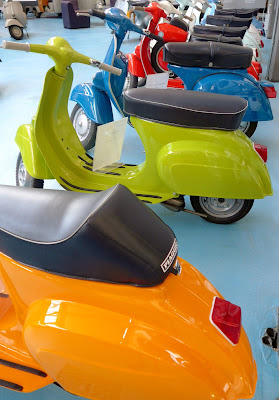Vespa Scooters are not technically my thing. I don't know much about tinkering with engines, and oil changes. I can appreciate cool though. And cool is what we got we got visiting Museo Piaggio in Pontedera, Italy.
We got cool, as in this, the Vespa Scooter,
...and cool, as we entered the air conditioned museum when it was forty degrees outside.
It's not all cylinder heads, top speeds and spark plugs. The Museo Piaggio knows how to appeal to many audiences.
Those who like a touch of Hollywood glamour.
Those who like colour.
Those who like the thrill of speed. Racing Vespas.
Those who like a bit of history.
Designed to be used in France in the Second World War, as far as I can remember.
And those who like to know how it all started.
The Vespa, designed Corradino d'Ascanio, an aeronautical engineer who who was not fond of 'uncomfortable and bulky' motorbikes, so set out to improve on them, designing the first in 1946.
Since 1946 Vespas have been mass produced,
proving so popular that in the first ten years they sold one million,
and four years later, they had sold their two millionth Vespa.
The Vespa has also been subject to much customisation influenced by...
...helicopters
...aerodynamics
...TV programmes
..and meat.
Museo Piaggio is housed in an old Piaggio factory,
which was damaged by bombing in the Second World War.
Three years after the end of the second World War, and two years after the two wheeled Vespa scooter was designed, in the same year Italy became a republic, Piaggio launched the Ape, a three wheeled van. It has proved to be Italy's most popular goods vehicle, selling 200,000 in ten years.
As with the Vespa they soon moved on from post-war military paint colours.
To red, for fire engines,
and designs from Sicily.
The Ape has been tested to extremes with several round the world expeditions.
Including a six month, 25,000 kilometre, journey from Spain to China across twenty countries to celebrate the Ape's fiftieth anniversary.
If you fancy customising your own Vespa, you have the chance in the kids area.
My kids weren't really young enough but enjoyed the opportunity anyway.
The Vespa, so called because "sembra una vespa!", "it looks likes a wasp!".
Old and new, has it changed that much in sixty-nine years?
Museo Piaggio is air-conditioned and open Tuesday to Saturday and the occassional Sunday.
Check their website, here, before you visit as you might just turn up at 1pm on a Saturday when they're closed for an hour for lunch. Just time enough to pop into town for an ice cream.













































